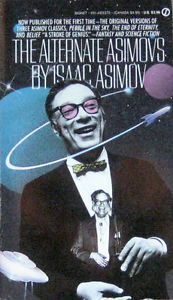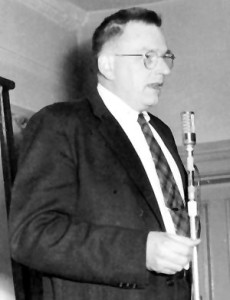 I said in my post on Asimov’s birthday a few days ago that I was going to read some stories from The Winds of Change. I did, getting through the first four stories before my eyelids grew heavy. The third story is the oldest in the book, “Belief” from 1953. Asimov notes in his introduction to the story that this was its first appearance in one of his American collections. (The reasons are beyond the scope of this post.)
I said in my post on Asimov’s birthday a few days ago that I was going to read some stories from The Winds of Change. I did, getting through the first four stories before my eyelids grew heavy. The third story is the oldest in the book, “Belief” from 1953. Asimov notes in his introduction to the story that this was its first appearance in one of his American collections. (The reasons are beyond the scope of this post.)
I thought I had read it somewhere, perhaps in The Great SF Stories, but the ISFDB said otherwise. It did, however, show that the story had been published in a later collection, The Alternate Asimov’s. I had a copy I had picked up years ago that I’d never read, primarily because I didn’t have time to read the original and final versions of the novels The End of Eternity and Pebble in the Sky. The Alternate Asimovs contains the original versions of those novels. It also contains both version of the novelette “Belief”.
It seems the version of the story John W. Campbell, Jr. published in Astounding wasn’t Asimov’s preferred version. Campbell required Asimov to rewrite the ending significantly. I read the original version, and found the experience quite enlightening.
According to the notes in The Alternate Asimovs, Campbell had suggested the premise to Asimov. The story is about Roger Toomey, a physicist at a small college. He wakes up one morning with the ability to levitate.
This causes him a number of problems, as this new ability is not entirely under his conscious control. After being observed levitating unintentionally by the department secretary and some students, he gets in trouble with his department head and the dean. He gets in further trouble when writes to a number of leading theoretical physicists asking if they could think of a physical mechanism to explain levitation.
Naturally, they think he’s a crank. The most prominent of these physicists named Deering is friends with Toomey’s department head, and since he wrote these letters on departmental stationary, he gets a medical leave.
In order to prove his case, he attends a small conference hosted by Deering. He comes in after the talks start, sits in the back of the room, and levitates every time Deering takes the podium to speak. When Deering stops speaking and challenges Toomey, Toomey denies having done anything. Eventually, Deering comes to Toomey’s hotel with an FBI agent and offers Toomey a position if he will admit he can levitate.
The ending is upbeat, and while Toomey endures disbelief and skepticism at the hands of his fellow scientists, this isn’t the ending Asimov had originally intended but one more in line with what Campbell wanted.
In the original version, Toomey is convinced by a psychiatrist friend to turn his ability into a stage act, saying that he’ll never convince his colleagues of his ability, that they won’t accept it because it doesn’t fit their belief system. Although he initially is a hit and rakes in the dough, he loses his booking. The owner of the club where he’s performing has figured out that this isn’t a stage act, it’s for real. Toomey doesn’t know how to work the crowd but just shows off. Ultimately they will figure out Toomey is for real. And while the audience at a magic show likes to be fooled, they want the comfort of knowing it’s a trick and what they’re seeing isn’t real.
Toomey goes home dejected to find a note from his wife, saying she can’t take it anymore and has left him. Toomey commits suicide by taking a bottle of sleeping pills. A neighbor notices the front door isn’t closed, goes in to investigate, and leaves the house screaming at the sight of the corpse.
When they police show up, they make an interesting discovery. Rigor mortis has caused whatever physiological mechanism responsible for levitation to activate. Even in death, Toomey is levitating, though only an inch or two off the bed. One of the cops pushes down on the body, there’s a soft pop, and Toomey drops to the mattress. The cop refuses to believe what he saw.
Campbell didn’t like the original ending and insisted that Asimov change it to an upbeat one. This wasn’t unusual for Campbell, although he was by no means the worst editor at this practice.
Both stories are well written and differ only in the final third. Also, both stories have endings I found satisfying. I found the upbeat ending, which was entirely conceived and executed by Asimov, to be clever. Toomey’s approach to levitate and then deny having done so to Deering was perfect.
On the other hand, I’m not sure such a thing could have been pulled off successfully. The ending also raises the question of why Toomey didn’t demonstrate for his department head and dean. The explanation that they wouldn’t believe even if they saw Toomey levitate didn’t really wash, especially since Deering did eventually believe when he saw.
I’m afraid I have to say the more negative ending is the one I find more realistic. There are some things we refuse to believe, even when the evidence says otherwise. Asimov pointed this out quite effectively in his original version of “Belief”.
Inexpensive copies of both The Alternate Asimovs (which has Asimov’s account of the writing of “Belief”) and The Winds of Change are plentiful on the internet.


